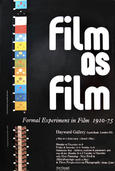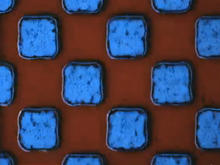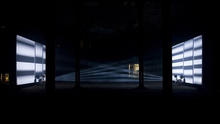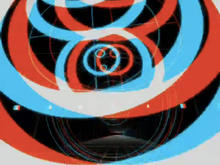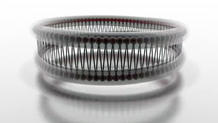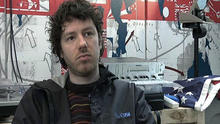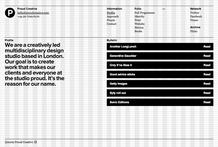Lis Rhodes
(*1942) is an avant-garde filmmaker and artist in Britain. She studied Film and Television at the Royal College of Art. Her films are feminist oriented and poetic.
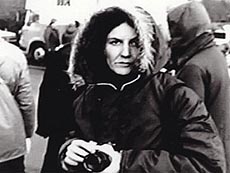
Since the early 1970s, Lis Rhodes has been a trailblazer in the art of experimental film. Rhodes began incorporating performance, photography, text, and spoken word into films creating works that voice feminist ideas in relation to the dominant cultural practices of the time and in relation to gender inequality.
Rhodes was a student at North East Polytechnic and the Royal College of Art, in London, in the mid to late sixties. Later, Rhodes worked as the cinema curator at the ground-breaking London Filmmakers' Co-Op (LFMC). LFMC was the first artist led filmmaking co-operative that incorporated production, distribution, and exhibition within a single facility and encouraged the exploration of experimental filmmaking. LFMC was the center for the discussion, production, and presentation of avant-garde film.
Rhodes was instrumental in drawing attention to the lack of women's representation in the arts and filmmaking. In 1979, she was the only female artist asked to participate in the planning of the exhibition Film as Film: Formal Experiment in Film 1910-1975 held at the Hayward Gallery in London. Working on the show and its catalogue in collaboration with other prominent women filmmakers—and after initially deciding to concentrate on the history of women filmmakers—Rhodes and her colleagues decided to withdraw from the exhibition to protest the lack of support their project encountered. Instead, the embattled group left their exhibition spaces empty and submitted a series of articles for the exhibition catalogue entitled Women and the Formal Film.
In addition to her artistic endeavors, in 1980, Rhodes and fellow filmmaker Felicity Sparrow founded Circles Women in Distribution, a feminist collective dedicated to furthering female filmmaking. Rhodes also served on the Greater London Council as an art advisor from 1982-1985. She currently teaches at Slade School of Art and Goldsmiths College in London, England, where she resides.
Source: National Museum of Women in the Arts
To attempt to write about Lis Rhodes’ work is difficult – her engagement with the failures and power structures of language make any simple description of her films impossible. These are not films that one can describe from the outside: they demand an engagement of the senses and intellect. Language is at the heart of her work and is active as a site of exploration.
Lis Rhodes investigates how language can produce perceptions, interactions and social relationships. While firmly rooted in the history of experimental film, Lis Rhodes’ films cross into performance, photography, writing, and political analysis. Performance can be seen in her early collaborations with Ian Kerr (Rumour Shock for the Lab.R, 1974, Cut A X, 1976, Bwlhaictke, 1976), as well as in her expanded cinema work when the viewers themselves become performers (Light Music, 1975). Photography appears a number of times, where the still image becomes animated through both its repetition (such as Orifiso, 1999), and through its re-representation (for example in the use of blown-up photocopies in Pictures on Pink Paper, 1982). Political analyses occur explicitly (for example in the discussion of the condition of migrant labourers in Running Light, 1996) and implicitly (such as the description of female experience in Pictures on Pink Paper).
Lis Rhodes brings a strongly political agenda to cultural practice through interrogations of the languages of film, through slippages between textual, visual and aural language, and through exposing power imbalances. This commitment is also seen in her involvement within the actual culture of avant-garde filmmaking itself. During the mid-1970s she programmed the London Filmmakers’ Co-op, and was an instrumental force in the setting up of the feminist distribution and filmmaking collective Circles. Circles was set up, with Felicity Sparrow, to address how the work of women filmmakers effectively ‘went missing’.
Lis Rhodes’ commitment to the issue of visibility can also be explicitly seen in her withdrawal from the exhibition Film as Film, at the Hayward Gallery in 1979. Lis Rhodes was initially the only woman invited to become involved in the planning of the exhibition, and in response to the lack of women’s representation within the exhibition committee, Annabel Nicolson was asked to take part. Together Lis and Annabel decided to concentrate on researching the history of female filmmakers. They were joined by other key women filmmakers - Felicity Sparrow, Jane Clarke, Jeanette Iljon, Mary Pat Leece, Pat Murphy and Susan Stein. The group made the decision to undertake an act of resistance to this gender imbalance by withdrawing from the exhibition but including in the Hayward catalogue a series of articles - ‘Women and Formal Film’. By challenging the didactic and closed nature of those artists and filmmakers selected to present work, the group asserted an objection to the lack of institutional engagement with feminist film practice. (Lisa Le Feuvre)
Source: LUX
